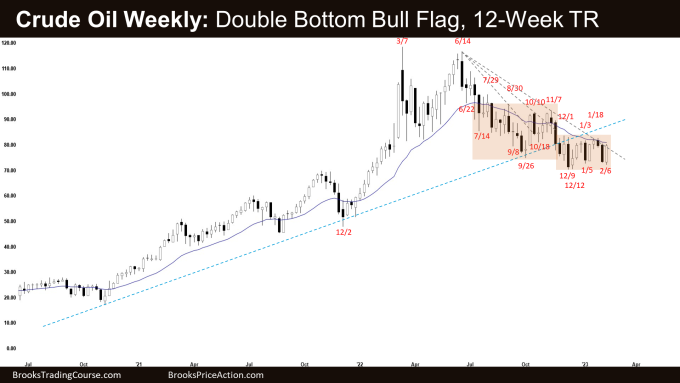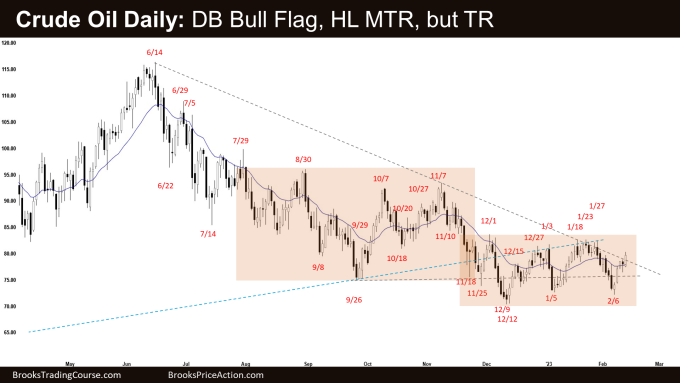Market Overview: Crude Oil Futures
The Crude oil futures is in a 12-week trading range on the weekly chart. Poor follow-through and reversals are more likely within a trading range. Traders will BLSH (Buy Low, Sell High) until there is a breakout from either direction. Markets have inertia and tend to continue to do what they have been doing. 80% of breakouts from trading ranges fail.
Crude oil futures
The Weekly crude oil chart

- This week’s candlestick on the weekly Crude Oil chart was a big bull bar closing near the high.
- Last week, we said that the odds slightly favor Crude Oil to trade at least a little lower, possibly testing near the 11-week trading range low. Poor follow-through and reversals are more likely within a trading range.
- This week traded slightly lower but reversed into a big bull bar, erasing last week’s selloff.
- The bears got a reversal down from a double top bear flag (Dec 1 and Jan 18) but failed to get follow-through selling this week.
- The bears want another leg down breaking below the December low and completing the wedge pattern (the first two legs being Sept 26 and Dec 9).
- If Crude Oil trades higher, they want a reversal lower from a wedge bear flag with the first 2 legs being January 3 and January 18 around the 20-week exponential moving average.
- The bulls want a failed breakout below the September low and the bull trend line.
- They hope that this week was a reversal higher from a double bottom bull flag (Jan 5 and Feb 6).
- The bulls need to break far above the bear trend line, the 12-week trading range high and the 20-week exponential moving average to increase the odds of higher prices.
- Since this week was a bull bar closing its high, it is a good buy signal bar for next week.
- However, Crude Oil is trading just under the 12-week trading range high, bear trend line and 20-week exponential moving average. It is not an ideal buy setup.
- The last 12 candlesticks are overlapping sideways. That means Crude Oil is in a small trading range.
- Poor follow-through and reversals are more likely within a trading range. Traders will BLSH (Buy Low, Sell High) until there is a breakout from either direction.
- Crude Oil could be forming a trending trading range.
The Daily crude oil chart

- Crude Oil traded slightly lower on Monday but reversed into a bull bar. The market then traded sideways to up for the rest of the week.
- Previously, we said if the bears get follow-through selling, it could be the start of the bear leg to test the 10-week trading range low.
- Last week, Crude Oil retested near the trading range low and reversed higher this week.
- The bulls want a failed breakout below the September – November trading range and the major bull trend line.
- They want a reversal higher from a wedge bottom (July 14, Sept 26 and Dec 9), a double bottom bull flag (Jan 5 and Feb 6) and a higher low major trend reversal.
- Crude Oil is in a 12-week trading range. Until the bulls can break far above the top of the trading range and the bear trend line, the current move up could simply be a bull leg within a trading range.
- The bears got a reversal lower from a double top bear flag (Jan 3 and Jan 18) and a small double top (Jan 18 and Jan 27).
- This week, they were not able to get follow-through selling below the January 5 low.
- They hope that the current pullback (bounce) will stall around January high and form a wedge bear flag with the first two legs being January 3 and January 18.
- They want a retest and breakout below the December low forming the wedge pattern with the first two legs being September 26 and December 9.
- For now, Crude Oil should continue to trade sideways, forming bull legs followed by bear legs.
- Markets have inertia and tend to continue to do what they have been doing. 80% of breakouts from trading range fail.
- Traders will BLSH (Buy Low, Sell High) until there is a breakout from either direction.
- Poor follow-through and reversals are more likely within a trading range.
Market analysis reports archive
You can access all weekend reports on the Market Analysis page.